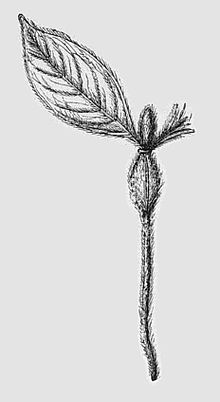| Duroia hirsuta | |
|---|---|

| |
|
Scientific classification
| |
| Kingdom: | Plantae |
| Clade: | Tracheophytes |
| Clade: | Angiosperms |
| Clade: | Eudicots |
| Clade: | Asterids |
| Order: | Gentianales |
| Family: | Rubiaceae |
| Genus: | Duroia |
| Species: | D. hirsuta
|
| Binomial name | |
| Duroia hirsuta | |
Duroia hirsuta is a myrmecophyte tree species from the Amazon Forest. It is one of some 37 species of Duroia, which are shrubs or canopy trees in the family Rubiaceae, favouring ants ( myrmecophilous), and occurring in Central America as far north as Mexico, the Amazon Basin, the Guiana Shield, the Brazilian Atlantic coast and planalto.
Plant Interactions
A number of Duroia species, and possibly all, are capable of biochemical interactions inhibiting the growth of neighbouring plants. Analysis of root extracts from Duroia hirsuta have yielded a strong plant growth inhibitor plumericin, a tetracyclic iridoid lactone, and duroin, another iridoid lactone. [1] [2]
This process, common amongst plants, is termed allelopathy. In the case of Duroia hirsuta, the chemical inhibitor is aided by the Lemon Ant, a resident on and in the tree, and playing an active role in suppressing and destroying plant growth in the vicinity of their host by injecting and spraying formic acid, and defending against herbivores - other ant species such as Azteca spp. and Allomerus octoarticulatus demerarae exhibit the same mutualism. [3] The area around this understory tree is often devoid of all other plant types, leading to the local name " Devil's garden." [4] The cost to the host plant for this protection is considerable, since the resident ants subject the tree to increased leaf cutting. [5] Trees that grow outside the cleared area often have the living tissues of their trunks excavated and galled for ant accommodation. [6]
The ants involved in the relationship specifically aid the plant in defense against herbivores, supplying of nutrients, and pollination. [7] [8] Their mutualism is strengthened by the positive size-dependent growth each gains from the relationship. [9] One specific type of ant, the M. Schummanni are notorious for supporting the largest plant sizes and growth rates. [10]
Environment Conditions
The environmental conditions that influence the fitness of the species also has an impact on the amount of rewards reaped by the ants involved in the mutualistic relationship with the plant. The effectiveness of ants is greater in conditions where nutrients are scarce as opposed to environments with favorable conditions for the plant. [7] Size of the plant is a great indicator of fitness and is often measured by the amount of Domatia present. [9] Ants can aid the plant in receiving more sunlight by clearing the canopies above the plant and limit competition from other nearby plants. [10]
References
- ^ J. E. Page; S. Madrinan; G. H. N. Towers (1994). "Identification of a plant growth inhibiting iridoid lactone from Duroia hirsuta, the allelopathic tree of the 'Devil's Garden'". Experientia. 50 (9): 840–842. doi: 10.1007/BF01956467.
- ^ Rita Aquino; Nunziatina De Tommasi; Medardo Tapia; Maria Rosaria Lauro; Luca Rastrelli (1999). "New 3-methyoxyflavones, an iridoid lactone and a flavonol from Duroia hirsuta". Journal of Natural Products. 62 (4): 560–562. doi: 10.1021/np9803631. PMID 10217708.
- ^ Megan E. Frederickson (2005). "Ant species confer different partner benefits on two neotropical myrmecophytes". Oecologia. 143 (3): 387–395. doi: 10.1007/s00442-004-1817-7. JSTOR 20062261. PMID 15711821.
- ^ David G. Campbell; P. Mick Richardson; Arito Rosas Jr (1989). "Field screening for allelopathy in tropical forest trees, particularly Duroia hirsuta, in the Brazilian Amazon". Biochemical Systematics and Ecology. 17 (5): 403–407. doi: 10.1016/0305-1978(89)90057-4.
- ^ Megan E. Frederickson; Deborah M. Gordon (2007). "The devil to pay: a cost of mutualism with Myrmelachista schumanni ants in 'devil's gardens' is increased herbivory on Duroia hirsuta trees". Proceedings of the Royal Society B. 274 (1613): 1117–1123. doi: 10.1098/rspb.2006.0415. PMC 2124481. PMID 17301016.
- ^ "Ants are friendly to some trees, but not others". Science Daily. November 9, 2009. Retrieved May 3, 2011.
- ^ a b Baez, Et al. 2016. Ant Mutualism Increases Long-Term Growth and Survival of a Common Amazonian Tree, Museo de Colecciones Biológicas, Universidad Técnica Particular de Loja, Loja, Ecuador, Et alibi.
- ^ Frederickson, Gordon. 2009. The intertwined population biology of two Amazonian myrmecophytes and their symbiotic ants, Stanford, California: Department of Biological Sciences, Stanford University.
- ^ a b Frederickson. 2006. THE INTERTWINED POPULATION BIOLOGY OF SYMBIOTIC ANTS AND PLANTS IN THE AMAZON, Stanford, California: Stanford University.
- ^ a b Frederickson. 2005. Ant species confer different partner benefits on two neotropical myrmecophytes, Oecologia, Plant Animal Interactions.